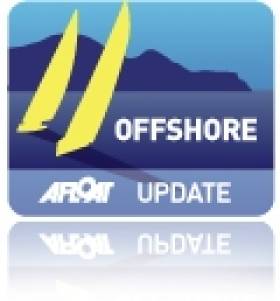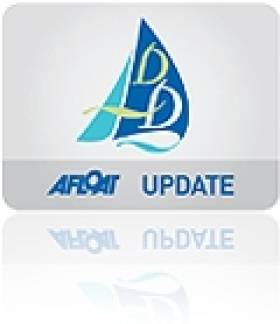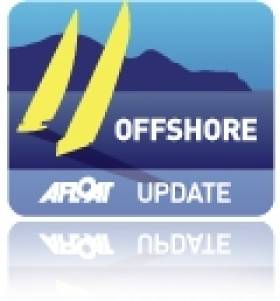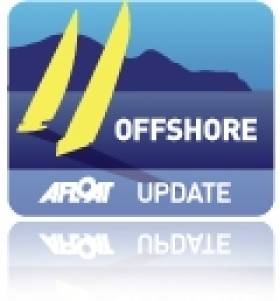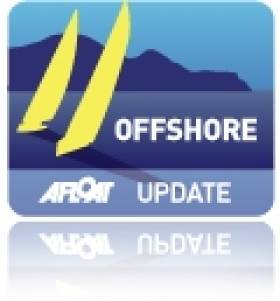Displaying items by tag: Offshore
Three Boats arrive in Punta del Este within 80 minutes
After nearly four weeks at sea and more than 6,700 miles of racing through the Southern Ocean and the South Atlantic from New Zealand to Uruguay, the fight for second place came down to a nail-biting drag race to the finish line.
As a flotilla of boats took to the waters off Punta del Este to witness the finale and welcome in the skippers they were greeted by two unmistakable shapes on the horizon – Operon Racing and Spartan neck and neck, separated by less than a mile. With around a mile to the finish line it was CSM who had the slight advantage but after taking a course too close to the shore he was forced to gybe twice to lay the line, allowing Gutek to capitalise.
In an amazing photo finish it was Gutek who emerged the victor, sneaking in front of CSM right at the last moment to clinch second place by less than a minute. Gutek crossed the finish line at 4.40pm local time (1840 UTC) after 25 days, 17 hours and ten minutes. Forty seconds later, CSM crossed.
And in an exhilarating conclusion to the leg, Canadian Derek Hatfield blasted across the line just over an hour later after 25 days, 18 hours and 22 minutes. Following Brad Van Liew's win on Tuesday afternoon, all four boats arrived in just over 48 hours of each other.
"It was a fight to the end and I won," Gutek said after stepping on to the dockside to rapturous applause from the waiting crowds. "This second place is the best of all of them, much better than in Wellington and Cape Town. I am really proud."
Moments later it was CSM's turn to join his fellow skippers on dry land. "This sprint has proven I have a fast boat and I have taken the handbrake off now and I think we have a good chance for the next leg," he said. "We have lost out on second place and that's a great pity, I wish we were parked one boat closer to Brad, but I think we have made our point – we know what we're doing now and we can go fast."
"Never in a 6,000-mile leg have I seen a finish this close," Derek added. "It was incredible. All I can say is wow, what a race. It was so close, I loved it."
Ocean sprint three has by no means been easy going for any of the VELUX 5 OCEANS skippers. In the middle of the Southern Ocean, thousands of miles from anywhere, CSM's mainsail ripped and he was forced to spend 30 hours stitching it in horrendous weather conditions. He also had to contend with rips in one of his foresails as well as a major water leak onboard Spartan.
Gutek faced a nervous rounding of the mighty Cape Horn when keel problems developed onboard Operon Racing. After a composite part on the yacht's keel pins broke, the keel started to move several millimetres, making a dull knocking sound. Gutek was forced to fully cant the keel for the remainder of the race, affecting his performance.
Onboard Active House Derek was dealing with an engine oil leak which meant he could only charge his batteries when on port tack. After holding on to second place until just two days from Punta del Este, it was low power to his wind instruments that was Derek's eventual downfall.
"The results of this leg really bode well for the future of the Eco 60 class," Derek concluded. "Here we have recycled older boats that are so competitive and level – it makes for great racing."
Ocean sprint four will see the fleet sprint 5,800 nautical miles to Charleston, starting on March 27.
FINAL POSITIONS:
1st Brad Van Liew - 23 days, 17 hours and 46 minutes
2nd Zbigniew Gutkowski - 25 days, 17 hours and 10 minutes
3rd Chris Stanmore-Major - 25 days, 17 hours and 10 minutes 40 seconds
4th Derek Hatfield - 25 days, 18 hours and 22 minutes.
SKIPPER QUOTES:
Gutek: "The end to my sprint three story is amazing. This second is the best of all of them, much better than in Wellington and Cape Town. I am really proud. For the last 48 hours I worked so hard to get every last bit of speed out of my boat. Six miles from the finish I was leading Chris, and then more wind came and he went past me. I hoisted my gennaker and we were neck and neck. It was a fight to the end and I won."
CSM: "It's been a very interesting day. This morning I got a position update saying Gutek was only one mile behind me. I was hoping that the tack I was about to do would put me ahead of him but I saw him about 11am pass in front of me about a mile ahead. He is sailing that boat out of his skin. I just couldn't catch him going upwind. Then the wind clocked round so we were on a reach and that's what Spartan does best. Suddenly we were doing 13 or 14 knots and we chased Gutek down pretty quickly. Coming into Punta I had about a fix-boat lead on him and everything was looking really good. Then, coming towards the line I got too close to a patch of rocks which was an error on my part. I had been on deck concentrating on the sailing. I had to put two gybes in to get to the finish line and that allowed Gutek to pass me in the dying moments. I ended up finishing 40 seconds behind him rather than 40 seconds ahead, but that's racing, that's what it's all about. This sprint has proven I have a fast boat and I have taken the handbrake off now and I think we have a good chance for the next leg. We have lost out on second place and that's a great pity, I wish we were parked one boat closer to Brad, but I think we have made our point – we know what we're doing now and we can go fast."
Derek: "All I can say is 'wow, what a race'. It was so close, I loved it. It was a lot of work but not as much effort as sprint two. It was a good leg, a fun leg. We had a really fast passage to Cape Horn and then an amazing rounding of the Horn within a mile of the coast. The second part from Cape Horn, the last 1,000 miles, was the most difficult part. Not that long ago I was in second place but all I can say is in the last few days the wheels really fell off. Because of the oil leak in my engine my power got so low that my wind instruments wouldn't work. In the dark I was going back and forth trying to get upwind, and that's when Gutek got away. It was mine to lose. The results of this leg really bode well for the future of the Eco 60 class – here we have recycled older boats that are so competitive and so level. It makes for great racing. Never in a 6,000-mile leg have I seen a finish this close, it was incredible."
Solo Sailing Conference Offers Charter of Performance Yachts
Irish solo sailing fans may be interested in the annual Solo Racing Festival at the Royal Southern Yacht Club, Hamble on Saturday 12th March.
Given the Figaro race is coming to Dun Laoghaire in August a talk on the Artemis Academy with John Thorn (Figaro 2) will be of particular interest.
Owen Clarke's designer Merfyn Owen, who lives in Hamble will be attending as well as colleagues from their brokerage partners Boatshed Performance.
So whether your interest be solo sailing or short-handed sailing in general they will be there to answer questions on design, construction, as well as sale/purchase and charter of offshore performance yachts.
The Race Fair is an open house from 10.00 for race organisers to meet and greet potential skippers from; Global Ocean/Class 40, Mocra, UK mini group, RORC, SORC, Biscay Challenge, AZAB. Floating boat show, 8 boats including the OC class 40, 2 minis, A35, J105, Figaro 2, Sunfast 3200.
There is a Book Signing, Alex Bennett signing copies of High Seas High Stakes and showing Fuji DVD Mike Golding is opening the talks at 11,00.
Followed by:
Winning Mind Set with Ian Brown, sports psychologist
Global Ocean race with Oliver Dewar
Two Star/Ostar with John Lewis, RWYC
30m trimaran design with Nigel Irens (Idec, Sodebo)
Artemis Academy first term report with John Thorn (Figaro 2)
Route du Rhum with Marco Nannini, (class 40)
all in the spendid riverside setting of the Royal Southern Yacht Club, Hamble.
More HERE.
Dun Laoghaire to Dingle Race 2011 is Launched
The possibility of an Open 40 entry plus a new white sail division are just some of the developments for the tenth Dingle Skellig Hotel Dun Laoghaire to Dingle Race. Over 50 (SCROLL DOWN FOR PHOTOS BY MICHAEL CHESTER) gathered at the National YC in Dun Laoghaire last night to hear local TD and the Minister for Sport, Tourism and Culture Mary Hanafin give a ringing endorsement for the unique 320-mile offshore race when it sets sail on June 11th. A notice of race and entry form is available for download below.
The last race attracted 39 entries and a course record was set by Michael Cotter's Whisper. This year organisers Martin Crotty and Brian Barry along with Dingle Harbour master Brian Farrell are confident that they will break the 40 boat barrier. They may well be right as the event has been specifically timed to bring Dublin boats to the south coast for ten days of racing at the ICRA Nationals in Cork Harbour and the Sovereigns Cup the following week in Kinsale.
The event is also benefitting from inclusion in this year's ISORA calendar.
Present last night were represntatives from the major Bay clubs, including Breda Dillon from Howth YC and Fintan Cains of ICRA. Peter Ryan of ISORA, who is also the National YC commodore spoke about plans to develop off shore sailing and the club's plans to welcome the international Figaro offshore fleet in August.
Solo sailor Mick Lidddy who is making a bid for an Irish entry into the race was also in attendance.
SCROLL DOWN FOR LAUNCH PHOTOS BY MICHAEL CHESTER
Afloat coverage of the 2009 Race is HERE
Foxall Recalls Barcelona Race
The pair set an inaugural course record of 92 days, 9 hours, 49 minutes and 49 seconds over the round the world route, although the first edition of the race began earlier in the year – on November 11, 2007.
Foxall is currently immersed in another round-the-world project, as part of the Groupama team preparing for their entry in the 2011-12 Volvo Ocean Race – his fourth participation in the race. With less than 24 hours to go until the start of the second edition, they asked him to cast his mind back to the Barcelona World RACE start:
What feelings do you have looking back at this pre-start period of the Barcelona World RACE?
"Like any oceanic race it's an accumulation of a huge amount of effort in terms of just getting the project to the startline. The race is quite often just the end part of what is quite a long process by the skippers to realise the boat's potential, along with the shore team and the designer and the sail designers. And to a certain extent for a lot of them they'll have had the resources and time to put a bit of the writing on the wall already, in other words to arrive with the very best boat and the very best possible team they can.
"Of course what happens over the next three months might end up telling a different story but most of the guys will hope they already have done what they can to have the best boat and the best possible outcome in the race."
What is your assessment of the fleet, who are your favourites to win?
"I think Jean Pierre Dick and Loick Peyron on Virbac-Paprec 3 are of course going to be one of the favourites, they've got various successes with the Transat Jacques Vabre together, and each have more and more. I certainly hope for the best and wish good things for them.
"It's actually quite an impressive line up with Michel Desjoyeaux and Foncia, and I'm sure that will be one of the main boats Jean-Pierre and Loick have to contend with. I think Groupe Bel will have a very, very good team as well, though they're possibly less well known to the general public outside of France.
"I'm not sure what stage Alex Thomson is at, but I think that was a very good pairing with Andrew Meikeljohn. I've sailed a lot with Andy and I'm sure whatever happens they would have had a good time.
"Jean-Pierre and I had been working towards doing it again when other projects came up, and I'm pretty sure if it wasn't for the Volvo Ocean Race I'd be there this time. So I'll be rooting for my home team and hope their new boat proves fast and reliable. I know they're both more than capable of delivering the goods."
Were there any favourite moments of the race for you when you'll be thinking about the skippers in this edition?
"The halfway mark is quite an experience. By that stage there's a certain amount of writing on the wall and you're hopefully well into your stride. Halfway round the world you've settled into a rhythm and you know what your boat is capable of, you know what the other boats are capable of and so I think it's a fairly significant moment. When you go through the Cook Strait and you look east into the Southern Ocean and you're halfway round the world that's quite a memorable mark of the course I guess.
"Obviously Cape Horn is a classic. But I think the biggest memory for me was coming back, the last stage into Barcelona and the contrast from three months at sea and coming back to modern life makes quite an impression, and especially so for us, winning the first edition. It's a great landmark for all of us to come back in."
Is there anything you took from the race you'd pass on to the skippers heading out tomorrow?
"It's a huge challenge and most of the skippers who are there have either been there before or have similar experience to myself so I'm not sure I'd pass on anything that the guys don't already know.
"But it's a long way, it's three months at sea, and unlike the Vendée Globe you're going to sea with somebody else, and it's not like the Volvo where you've got a larger group of people. You're going to sea with one other person and that's probably the most important aspect in terms of the race.
"On the one hand it's the biggest attribute you've got, your buddy, your co-skipper. And it's really important to make that relationship work well and to understand what they need, and to maintain a single objective in common that you both agree on and to basically cross the line having achieved that goal. For some it might be winning, for some it might be just finishing the race, but that common objective is probably the single most important thing that the skippers need to agree on before the start."
Proposed Irish Sea Conservation Zones
The area include the inshore waters of Merseyside, Lancashire and Cumbria and offshore waters of the Isle of Man, Wales, Northern Ireland and England. One of the zones is a 187 square km stretch of deep water between Northern Ireland and the Isle of Man.
In order to gain a greater understanding of the proposed zones, the report commissioned a Regional Stakeholder Group which drew from a diverse range of interests in the Irish Sea. Among the stakeholders included were the Royal Yachting Association, the fishing community and ports authorities. The review identified the size, shape and locations of the proposed 10 ten new Marine Conservation Zones. For the first time, the zones included inshore water of the Irish Sea project area as well as offshore.
"This is a real milestone for the project, with potential Marine Conservation Zones identified in both inshore and offshore waters", said Greg Whitfield, project manager at Irish Sea Conservation Zones.
"It is now really important that people take a look at the potential zones and give us their feedback on them. The better the information we have, the better the Marine Conservation Zones that are recommended by the regional stakeholder group will be."
Each of the marine conservation zones are designed to protect nationally important marine wildlife, habitats and geology. In addition they are designed to have the least impact possible on people's activities, but some restrictions will apply as the zones must meet guidelines for protecting species and habitats.
Members of the public are being invited to participate and will be considered as the second project continues to refine its proposals. The report is only a snapshot of the work so far. It does not contain concrete recommendations for the locations of Marine Conservation Zones (MCZ) in the Irish Sea, and the potential zones shown in the report are described as tentative and liable to change.
The Irish Sea Conservation Zone project will be releasing a third report before the Regional Stakeholder Group finalises its recommendations. The reports are delivered to the Science Advisory Panel. The independent body is comprised of expert scientists whose main role is to evaluate the potential of MCZs against ecological criteria.
The third progress report will be made available in February 2011. Its final recommendations will then be presented to the UK government in June. Following that a formal public consultation on the proposed MCZs are to take place in late 2011 and early 2012.
For information on the Second Progress Report including feedback forms can be downloaded from HERE or by calling 00 44 (0)1925 813 200
Poll Shows Raging Bull as Favourite for ICRA's Boat of the Year
With just 24 hours to go to the announcement of sailing's boat of the year award at tomorrow's Cork harbour ICRA conference the consistent poll topper from Afloat's online survey shows ISORA offshore champion Raging Bull as a clear favourite with 1175 votes. Second is Marinerscove on 873 and Errislannan third on 256 votes. Polling began just over a month ago and 2,600 votes have been cast. See the poll on the left hand column of the home page. There's still time to cast your vote to try and influence ICRA judges!
2011 ISORA Race Schedule Published
ISORA has published its race schedule for 2011 and to win the overall series next year boats must complete 4 of the 6 "qualifying". Points for the overall series will then be taken from the Best 5 results from ALL the races completed.
The offshore body has also changed the scoring of each race to the High Score system and it will apply weightings for those qualifying races depending on the complexity of the race. The aim is to better reward the winner and participants of longer races with bigger fleets.
To provide opportunities for those boats who have not been winning to win prizes and trophies, it was also agreed at last weeks agm to create a "Silver" fleet in both Class 1 and Class 2. The selection of boats to enter the "Silver" fleet for 2011 will be based on their performance in 2010. The success of these new classes will depend on maintaining the number of boats entering and racing at least at last years numbers.
The NOR and Entry forms for ISORA 2011 will be published later this month.
The Race Programme is attached for download below.
Black Tie Finale to ISORA Season
Irish Sea Offshore sailing Chief Peter Ryan has circulated the Notice and Agenda for next Saturday's ISORA AGM at the National Yacht Club and told Ireland's biggest band of offshore crews to wear dinner jackets so they can vote on next year's sailing, watch Ireland play South Africa and attend the formal ISORA prize giving dinner all at the same waterfront venue.
The AGM takes place at 14.00 at the NYC. The rugby match is on at 17.30 and Ryan says if sailors are interested they can dress up in your tux and watch the match.
Immediately after the match at 19.45, the pre-dinner drinks reception will be held in the JB Room of the Dun Laoghaire club with complimentary sparkling wine and classical music by the Neptune Trio.
Dinner will be at 20.30 sharp to enable the prize giving to take place at 22.00 and finish of ceremonies by 23.00 latest. After this sailors can relax or dance the night away at the ISORA disco.
AGM papers are attached for download.
Foxall Podcast from Volvo Ocean Race
All to Play for in Middle Sea Race
The group of boats that arrived at the finish line in Marsamxett Harbour this afternoon spent most of the 600 miles within reach of each other, and how they made some key tactical decisions along the way would make or break their results.
Dun Laoghaire's Legally Brunette is over the top of the Sicily and heading for home. Tonight at 2000 hours she was heading 122 degrees and doing seven knots. The screen shot below from the race tracker shows the sole Irish boat (marked by a red box) in the top left hand corner.

Vladimir Proshikin's chartered Volvo 70 E1 (RUS) crossed the finish line at 12.35 today, in fourth place on elapsed time. The Russian sailor, from St Petersburg competed last year on his Shipman 72, a performance cruiser/racer, quite the polar opposite of this five-year old round-the-world ocean racer. While the conditions were lighter this year, the crew had a workout with numerous sail changes, a net wrapped around the keel and a canting keel stuck off center for the last ten miles. Still, on the quay after the finish, Proshikin was clearly elated and quite animated in relating the trip. "This race was a bit slower, but in light air it's even more demanding. It was fun and it's quite intriguing, but took a bit longer so we are a bit tired. It's a vey impressive race, difficult conditions, with many islands -- it's not like running 600 miles from start to finish in a straight line, it's tricky.
"We had some bad luck a couple of times, catching the net around the keel for several hours (which required a neat trick where they sheeted in the main and canted the keel the wrong way, so a crew member could 'walk' out and then get in the water to dive and cut it away). We're on the boat for the first time as a crew, with only a week of training, and it's a very complex boat. Sometimes you are lucky, and sometimes not...but overall, I'm happy!"
But it was Bryon Ehrhart's TP52 Lucky, that crossed the finish line after 3 days, 3 hours, 16 minutes, which put the US boat on top of the leader board on corrected time, for now.
The Chicago-based skipper/owner has had the Rolex Middle Sea Race on his 'to do' list for awhile and has methodically planned a race schedule – that included last year's Rolex Fastnet Race – that would give them some good practice and put them in the Med this year. Ehrhart said, "What a great race and probably the best offshore race we've done in terms of the style of race. Getting up through Messina was a challenge on it's own – it's like multiple regattas within one large long race, it's very scenic, but there are opportunities to screw up all over the place!
"But thankfully, Ian Moore is a fantastic navigator. We were very happy with the calls we made all the way around. Times where we thought we'd have a lifts, we generally had lifts; times we'd thought we'd get knocks coming into important marks, we got knocks. So a lot of worry and decision about whether 25-50 miles out you're going to make the right decision about sailing this course to get to a knock or lift, and I put it up to his genius in getting us there.
"We spent a lot of time next to Wild Joe, she was actually an additional motivator. Several times we were in and out with her. The Cookson 50 (Cantankerous), Wild Joe, and Pace – we were on each others' mind all the time."
Ian Moore who, as a last-minute addition to the crew, seemed to have earned his keep with their impressive performance. The Irish Volvo Ocean Race veteran and BMW Oracle America's Cup crew member said, "It was good race, pretty exciting, lots of lead changes. We were pleased every time we managed to pass (the TP52) Pace, and then their boat speed got up again, and then we got another opportunity. Lots of moments the race would restart and give us the option to use our abilities.
Of the difference between the two TP52s, Moore said, "They are very different vintages. Pace was built for the TP52 Worlds in Miami and is an ultra-light racing machine. Lucky was designed to race across the Pacific Ocean and be able to keep the crew on board on that 3000 nm passage. Pace is an inshore racing boat, and Lucky is an ocean-going boat, a lot heavier, stronger. But, it's nice for me to sail on this boat, to know this is a good, strong and safe boat. Every time you take a normal TP52 on a race track, you are always crossing your fingers and hoping it's going to stand the test of time."
Moore enjoyed the course and said, "It is a spectacular course; it's a circular course, start and finishing in Malta. Going up to the Strait of Messina and just running into that five knots of current, apparently from nowhere, and going around the smoking volcano of Stromboli and all the islands, including Pantelleria, Lampedusa. They're like an island in the middle of nowhere, but there are always people living on there, no bigger than a view football pitches. It's really a pretty amazing race track; it's lovely to come and do it again."
This was Wild Joe's skipper/owner, Marton Jozsa third Rolex Middle Sea Race, though for most of his Hungarian crew it was their first-ever offshore race. Jozsa said, "I think this is the first good offshore racing result in Hungarian sailing, so I think we can be satisfied with this result – and we are! We have one guy from Australia with experience in offshore racing and it is very good to have this guy on board.
"We very much like sailing here in Malta and also in this race, so I hope we will be here again. Besides some races in Croatia, next year we are planning to take part in Rolex Capri Sailing Week in May – for us, the Rolex Volcano Race – and after, we will see."
Bret Perry, strategist and the lone Australian onboard Wild Joe, said, "The team is a bunch of dinghy sailors, and it's their first offshore experience. It's a new boat to Hungary, and not many people have seen a Hungarian sailing team. I didn't know quite what to expect myself, but once we got sailing on the boat, the crew was really fantastic, sailing 100%, and gave us every opportunity to finish where we finished.
"You have to be realistic and get out there and do your best, but to get what we achieved they should be really, really proud. They're all so talented, they're Olympic-level sailors, they know what's going on, they just need to understand the bigger picture and get out of windward-leeward type of sailing – and this is their first experience in an offshore boat.
Jonas Diamantino's Comanche Raider II, from the Royal Malta Yacht Club, has been taking a pasting but spirits are high, as he explained as they passed Pantelleria earlier today. "Pretty hectic, pretty scary. We got hit by a 45-knot squall, with very confused seas, and it was all on. But everybody is fine and so is the boat, but it was a tough few hours. We are now doing ten knots and heading for home. Tell the bar at the club to get the beer on ice!"
Lucky are currently leading overall on corrected time in IRC, but they have to withstand challenges from at least two boats that are in contention for the overall win. Sort of like history repeating itself, the two boats are the Lee Satariano & Christian Ripard's J/122 Artie, and John Ripard & Andrew Calascione's J/133 Jaru. The last time a Maltese boat won the Rolex Middle Sea race overall was Market Wizard in 2002 with Ripard & Calascione, and in 2001 it was Christian Ripard's Straight Dealer.
The Maltese Beneteau 411, Fekruna, retired just west of Stromboli, bringing the total number of retired boats to eight, with eight boats finished and 60 still racing.
The race fleet can be tracked online at www.rolexmiddlesearace.com/tracker/#tracker
The final prize giving is at 12.00pm on Saturday, 30 October at the Mediterranean Conference Center in Valletta.




























